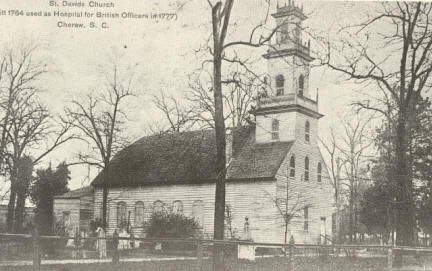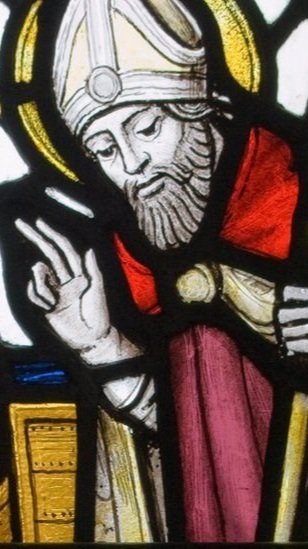Since 1768
St. David’s History
“In 1768 by an Act of General Assembly of the Province of South Carolina, St. David’s Parish was established to serve both the religious and the civic needs of a growing population. The new parish included much of the northeastern corner of South Carolina.
The Anglican Church was the established or state church in South Carolina, and the vestry was as much a political body as a religious one. The wardens and commissioners were responsible for the roads, the poor, orphans, voting and collecting taxes in addition to their church duties. The first commissioners were English, Irish and French as well as Welsh Baptist from the present day Society Hill area. The last colonial parish to be established in South Carolina was named for David, the patron saint of Wales, because the first large settlement in the area was by Welsh Baptists.
The first church building (now called Old St. David’s), was begun in 1770, in use by 1772, and completed in 1774 - just in time for the American Revolution. Cheraw was in the center of the unrest and was considered strategic by both sides. Consequently, St. David’s was used by both the British and Americans as quarters and hospital. After the war, the church was used infrequently, probably because of the unpopularity of the British. In 1785, the Anglican (English) Church was disestablished, and the vestry apparently did not meet again for 34 years.
After several decades, both the Baptists and the Presbyterians began using the church: but in late 1819, the Episcopal Church. successor to the Church of England in America, reclaimed the church. By 1826, the Episcopalians were strong enough to make the additions that changed the rectangular structure into what you see today.
The first ‘settled’ clergyman was the Rev. Andrew Fowler who came in 1819. He also founded a mission in Wadesboro, N.C. Later rectors founded the Episcopal churches in Society Hill (1834) and Bennettsville (1863). Two Episcopal Bishops were rectors of the old church: Alexander Gregg, first Episcopal Bishop of Texas, and Albert S. Thomas, Bishop of the Diocese of South Carolina.
The church grew and prospered in the 19th century, and a number of changes were made to the interior. The Civil War brought great suffering to Cheraw and to numerous refugees from the coast. The old church was used as a hospital by both armies. Although damaged by the war, the church miraculously survived being in the direct path of General Sherman’s Union troops. Growth after the war slowed, but gradually the church began to prosper again. A women’s group formed to meet some of the terrible needs of the community at this time.
By the turn of the century, the church was in need of more room. A new church building was begun in 1914 closer to the center of town. In 1916, the congregation moved into their large new Gothic style building on Market Street. The old church became a mission for the nearby mill village families and continued to be used by the congregation for this outreach for many years.” - Adapted from the 1999 Parish Profile
St. David’s Present
Nearly 100 years later, St. David’s, along with numerous other churches in the Diocese of South Carolina, found itself at odds theologically with its national governing body, the Episcopal Church. In 2012, the congregation of St. David’s voted to remain with its Diocese as the Diocese disaffiliated from the Episcopal Church. In 2017, the Diocese and all its affiliated churches joined the Anglican Church in North America (ACNA). Thus, St. David’s reclaimed its original identifier as St. David’s Anglican Church.
In 2022, as a result of disaffiliating from the national Episcopal Church, the South Carolina Supreme Court ruled that St. David’s, along with six other churches, was required to deed its property to the Episcopal Church. On July 31st of that year, St. David’s celebrated one last meal together in its historic property before marching from Market Street to Greene Street where it leased space from the congregation of Wesley United Methodist. We could not be more grateful for Wesley’s hospitality! After over a year of meeting at Wesley, St. David’s began holding join services at St. Paul’s, our sister church in Bennettsville. In April of 2024, St. David’s purchased two acres of land next to Kiser Funeral Home across from Arrowhead Park in Cheraw.
We Currently meet at Kiser on Sundays at 11am. All are welcome!
Who is St. David?
Despite the overwhelming victory of the pagan Angles, Saxons, and Jutes in the fifth century, one part of Britain continued in the ways of Christianity—Wales, the land west of the Wye River. In this last stronghold of the old Britons, the faith sprung from Glastonbury continued to flourish.
To the family of one Sanctus in Menevia there was born a son David (“the beloved”). Little is known of his early life, but while fairly young he founded a monastery, near Menevia and became its abbot. He was later elected bishop. His strongest desire was to study and meditate in the quiet of his monastery, but he was virtually dragged to an assembly of bishops called to combat the heresy of Pelagianism. Once there, David proved to be so eloquent and learned that Archbishop Dubricius chose him as his own successor as Primate of Wales. In time, David founded eleven other monasteries in Wales, and made a pilgrimage to Jerusalem.
He is said to have been strict in the governing of his own monastery at Menevia, yet loving in his treatment and correction of wrongdoers. One of his nicknames, “the Waterman,” may indicate that he allowed the monks in his care to drink only water at meals instead of the customary wine or mead.
A scholar, a competent administrator, and a man of moderation, David filled the offices he held with distinction. He became a leader and guardian of the Christian faith in Wales. Eventually he moved the center of episcopal government to Menevia, which is still an episcopal city, now called Ty-Dewi (House of David).
Some facts of his life can be historically established. Among them is that toward the end of his life he had several Irish saints as his pupils at the monastery. In legend—and many legends surround his life—David is clearly the foremost saint of Wales. He is revered and loved to this day as patron of Wales, foremost Christian priest, and courageous leader.
– Lesser Feasts and Fasts (2006)
What Makes St. David’s Unique?
Throughout the history of the Church, Christians have always been four things: liturgical, sacramental, missional, and evangelical. These things are in no way at odds with one another, and St. David’s believes in embodying all of them.
Our life together is rooted in the ancient, sacramental traditions of the church. We rely on centuries-old rhythms and emphases, trusting that as we walk in these ancient paths, we will find rest for our souls (Jer. 6:16). We believe, above all else, in the Gospel of Jesus Christ as it was delivered to the church through the Apostles - “that Christ Jesus came into the world to save sinners.” This message is good news because it means forgiveness, healing, identity, and union with God for all who accept and believe it. We also believe that the sacraments (Baptism and the Eucharist) are means of that forgiveness, healing, identity, and union with God.
liturgical
Everything we do finds its origin and purpose in worship. We worship according to the historic order of the Church, received through the tradition of the English reformation.
sacramental
We hold that Baptism and the Lord's Supper are not only outward signs, but instruments of God's grace, instituted by Christ himself and sustained by his presence.
missional
God sends us into the world to be living members of the Body of Christ. For this reason, we seek to make our work an act of worship, and our lives a witness to God's love.
evangelical
We believe in the Gospel of Jesus Christ, the Word made flesh. We submit to the final authority of Holy Scripture, and we acknowledge the continuing presence and power of the Holy Spirit.


